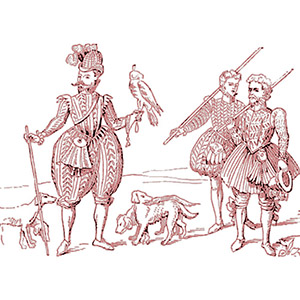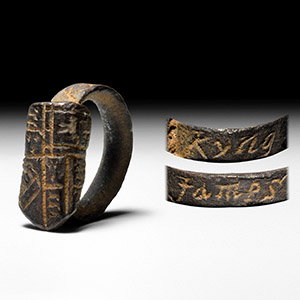Home > Stories by TimeLine Auctions
Stories by TimeLine Auctions
TimeLine Auctions Top The Royal Pecking Order

If you type the word Vervel in the Simple Search box on the Portable Antiquities Scheme’s website, you can browse several hundred records of vervels and associated finds brought to light by members of the public (mainly detectorists) in England and Wales since the scheme’s launch in 1997. If this is your first encounter with the word vervel, let me explain that it comes from the Old French vervelle meaning leg fetter. In turn, the Old French word derived from the Vulgar Latin vertibulum, which meant leg joint. By the time the word came into widespread use in medieval England it referred to a metal (usually silver) ring bearing its owner’s name and/or coat of arms; which attached to the jesses (tethers) that prevented a falcon or hawk rising from its perch until a hunt commenced.
At this point I must also mention small spherical bells enclosing a metal “pea” within. Silver, copper alloy, and other types are known; often smaller than 15 mm in diameter, with loops for attaching to clothing, or to pet collars, or to a hawk’s jesses. Such a bell served two purposes in hawking. First, as an aid to locating a hawk that had failed to return after release. If it perched on a branch in a leafy tree, its movements would cause the bell to ring or rattle, and thus indicate its location. Second, to warn any person seeing a bird of prey flying overhead, that its bell confirmed it was not a wild bird, and that it flew under rigorous ownership protection. A tight circle of medieval aristocratic families hedged around the monarch; each determined to retain hereditary privileges including the right to own land; to claim exemption from the king’s taxation; to tax their own tenants; and to enjoy a range of exclusive sporting activities, with falconry their dominant interest throughout several medieval centuries. Among themselves, the nobles allocated gradings and rankings to birds of prey, then decreed that only aristocrats whose status matched that of a particular bird held the right to own and to fly that species of hawk or falcon. Thus, none but a king could own and fly a gyrfalcon (the world’s largest bird of prey); while earls could own and fly peregrines.

An agricultural labourer with a few hens in his kitchen garden would, no doubt, have thought twice about hurling a stick at a bird of prey hovering above his poultry if the sound of a bell reached his ears just before he threw his missile. But as the popularity of falconry increased, so did the value of trained hawks and falcons. A rise in crimes involving thefts of birds during the 14th century prompted the introduction of a law that imposed a death sentence on anyone stealing a trained bird of prey. Later, in the reign of Henry VIII, the amount paid to any person who found a trained hawk or falcon, perhaps injured, or, for example, simply snared when its jesses became entangled in dense undergrowth, rose substantially. If the finder examined the vervel and recognized the name, or the heraldic device displayed on it, he could expect a reward of a gold angel (7s 6d) when he carried the bird to its owner’s address. In the same year another new law came into force imposing death by hanging on any person, anywhere in the kingdom, who found a stray hawk and failed to reunite it with its owner. Thefts of eggs from hawk’s or falcon’s nests brought punishments of equal severity.
The reigns of early kings of the Stuart Dynasty – James the First and Charles the First – foreshadowed a waning in the popularity of falconry as an aristocratic sport. The main causes were enclosures, cutting down of forests, draining of wetlands, and the introduction of shotguns. The aforementioned monarchs continued to fly their falcons throughout their reigns; but when Charles the Second returned from Continental exile in 1660 his entourage included men who had become expert in handling flintlock fowling pieces. They could kill gamebirds on the wing with a deadly accuracy that matched the performance of a stooping falcon. Proof that in non-aristocratic circles enthusiasm for training and flying the birds remained buoyant into the 18th century may be gleaned from contemporary provincial newspapers.
Here are two early examples of small ads relating to hawking:
Caledonian Mercury - December 1750
Catched in a Park near Leith, a HAWK with two Bells. The Gentleman to whom she belongs shall have her again, upon telling the marks on the bells, and satisfying the young man who caught her. And in the same newspaper, of the same date:
LOST upon the 7th December instant, a Hawk belonging to Mr. Mcdowall of Castletemple in the Shire of Renfrew. The Hawk has silver bells and vervels with the Word CASTLETEMPLE on them. Any Person that will be so good as to give notice where the Hawk may be recovered, to Mr. Mcdowall at Castletemple, shall be sufficiently rewarded.
An enthusiastic 21 st century revival of interest in the history of falconry has occurred thanks to the successes of detectorists in recovering vervels and equipment related to the sport. Some of the most interesting and best-preserved examples have found their way to auction houses where brisk bidding has achieved notable hammer prices. At TimeLine Auctions ten of the twenty-three vervels that have come under our auctioneer’s hammer since 2010, topped the £1,000 mark, with four reaching £2,000+ .. £3,000+ .. £7.000+ and £9,000+. TimeLine Auctions record price for a vervel was achieved in 2020 when a silver example that once belonged to King James the First, achieved a selling price of £23,493 (inc.bp). It comprised a flat-section hoop with the legend Kyng James in italic script; and a waisted heater shield with quartered arms of the Stuart kings. It was discovered by a detectorist searching near Angmering, West Sussex in 2016. Remarkably, a London auction house recently handled the sale of very similar silver vervel that carried the legend Kyng Charles, son and successor to King James. That detector find came from the Thames foreshore, a stones-throw from the Tower of London, where Charles the First kept some of his favourite falcons.
Aaron Hammond, TimeLine Auctions, 13th June 2024




